PHP origin and historical development

PHP origin and historical development
PHP (Hypertext Preprocessor) is a server-side scripting language, originally developed by Dennis Richez (Rasmus Lerdorf) in 1994 Created in year. The origins of PHP can be traced back to Rasmus Lerdorf developing a simple tool called "Personal Home Page Tools" to record his personal online resume and monitor website traffic. By 1995, Rasmus Lerdorf released the first version of PHP and renamed it "PHP/FI" (Personal Home Page/Forms Interpreter).
With the rapid development of the Internet, PHP has gradually become a popular server-side scripting language and is widely used in the field of Web development. PHP's grammatical style draws on C language, Java and Perl, and is easy to learn and use, allowing many developers to quickly get started and perform web programming.
During the historical development of PHP, it has experienced multiple versions of updates and improvements. In 1997, PHP 2.0 was released, introducing the concepts of classes and function libraries, making the code easier to organize and maintain. The subsequent PHP 3.0 version added functions such as support for MySQL database, further improving the practicality of PHP in web development. PHP version 4.0 was released in 2000, adding support for object-oriented programming, allowing developers to better encapsulate and reuse code. The PHP 5.0 version released in 2004 introduced many new features, such as exception handling, object-oriented improvements, and SQLite support, which further enhanced the functionality and performance of PHP.
Now, PHP has developed to version 7.x, continuously optimizing its performance and functions, and improving code execution efficiency and security. Below we will show some basic syntax and features of PHP through specific code examples:
- Hello World program:
<?php echo "Hello World!"; ?>
- Variables and data types:
<?php
$myVariable = "Hello PHP!";
$myNumber = 10;
$myArray = array("apple", "banana", "cherry");
?>- Control flow statement:
<?php
$number = 5;
if ($number > 0) {
echo "Positive number";
} elseif ($number < 0) {
echo "Negative number";
} else {
echo "Zero";
}
?>- Loop statement:
<?php
for ($i = 0; $i < 5; $i++) {
echo "The number is: " . $i . "<br>";
}
?>Through the above code example, we can see To PHP's concise and powerful syntax features, as well as its flexible application in Web development. As Internet technology develops, PHP still maintains its important position and becomes one of the preferred languages for the development of many websites and applications. We look forward to PHP continuing to innovate in future development to provide developers with more convenience and efficiency.
The above is the detailed content of PHP origin and historical development. For more information, please follow other related articles on the PHP Chinese website!

Hot AI Tools

Undresser.AI Undress
AI-powered app for creating realistic nude photos

AI Clothes Remover
Online AI tool for removing clothes from photos.

Undress AI Tool
Undress images for free

Clothoff.io
AI clothes remover

AI Hentai Generator
Generate AI Hentai for free.

Hot Article

Hot Tools

Notepad++7.3.1
Easy-to-use and free code editor

SublimeText3 Chinese version
Chinese version, very easy to use

Zend Studio 13.0.1
Powerful PHP integrated development environment

Dreamweaver CS6
Visual web development tools

SublimeText3 Mac version
God-level code editing software (SublimeText3)

Hot Topics
 1359
1359
 52
52
 CakePHP Project Configuration
Sep 10, 2024 pm 05:25 PM
CakePHP Project Configuration
Sep 10, 2024 pm 05:25 PM
In this chapter, we will understand the Environment Variables, General Configuration, Database Configuration and Email Configuration in CakePHP.
 PHP 8.4 Installation and Upgrade guide for Ubuntu and Debian
Dec 24, 2024 pm 04:42 PM
PHP 8.4 Installation and Upgrade guide for Ubuntu and Debian
Dec 24, 2024 pm 04:42 PM
PHP 8.4 brings several new features, security improvements, and performance improvements with healthy amounts of feature deprecations and removals. This guide explains how to install PHP 8.4 or upgrade to PHP 8.4 on Ubuntu, Debian, or their derivati
 CakePHP Date and Time
Sep 10, 2024 pm 05:27 PM
CakePHP Date and Time
Sep 10, 2024 pm 05:27 PM
To work with date and time in cakephp4, we are going to make use of the available FrozenTime class.
 CakePHP Working with Database
Sep 10, 2024 pm 05:25 PM
CakePHP Working with Database
Sep 10, 2024 pm 05:25 PM
Working with database in CakePHP is very easy. We will understand the CRUD (Create, Read, Update, Delete) operations in this chapter.
 CakePHP File upload
Sep 10, 2024 pm 05:27 PM
CakePHP File upload
Sep 10, 2024 pm 05:27 PM
To work on file upload we are going to use the form helper. Here, is an example for file upload.
 CakePHP Routing
Sep 10, 2024 pm 05:25 PM
CakePHP Routing
Sep 10, 2024 pm 05:25 PM
In this chapter, we are going to learn the following topics related to routing ?
 Discuss CakePHP
Sep 10, 2024 pm 05:28 PM
Discuss CakePHP
Sep 10, 2024 pm 05:28 PM
CakePHP is an open-source framework for PHP. It is intended to make developing, deploying and maintaining applications much easier. CakePHP is based on a MVC-like architecture that is both powerful and easy to grasp. Models, Views, and Controllers gu
 CakePHP Creating Validators
Sep 10, 2024 pm 05:26 PM
CakePHP Creating Validators
Sep 10, 2024 pm 05:26 PM
Validator can be created by adding the following two lines in the controller.




